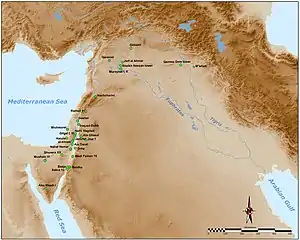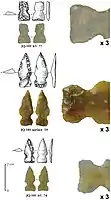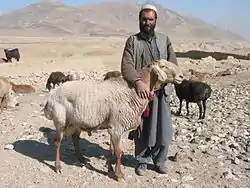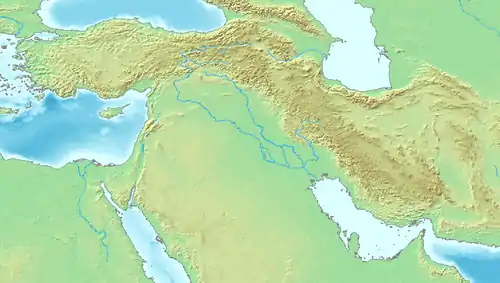Khiamian
The Khiamian (also referred to as El Khiam or El-Khiam) is a period of the Near-Eastern Neolithic, marking the transition between the Natufian and the Pre-Pottery Neolithic. Some sources date it from about 10,000 to 9,500 BCE (12,000–11,500 BP),[1] while the ASPRO chronology dates it to between 12,200 and 10,800 BP.
 Map of the Levantine sites with El Khiam points | |
| Geographical range | Fertile Crescent |
|---|---|
| Period | Neolithic |
| Dates | c. 10,200–8,800 BCE |
| Type site | El Khiam |
| Major sites | Azraq, Abu Madi, Mureybet |
| Preceded by | Natufian culture |
| Followed by | Pre-Pottery Neolithic |
| The Mesolithic |
|---|
| ↑ Upper Paleolithic |
|
| ↓ Neolithic |
Overview
The Khiamian owes its name to the site of El Khiam, situated on banks of the Dead Sea, where researchers have recovered the oldest chert arrows heads, with lateral notches, the so-called "El Khiam points".[1] They have served to identify sites of this period, which are found in Israel, as well as in Jordan (Azraq), Sinai (Abu Madi), and to the north as far as the Middle Euphrates (Mureybet).
Aside from the appearance of El Khiam arrow heads, the Khiamian is placed in the continuity of the Natufian, without any major technical innovations. However, for the first time houses were built on the ground level itself, and not half below ground as was previously done. Otherwise, the bearers of the El Khiam culture were still hunter-gatherers, and agriculture at that time was then still rather primitive, based on what has been reported on sites of this period.[2] Newer discoveries show that in the Middle East and Anatolia some experiments with agriculture were being made by 10,900 BCE.[3] and that there may already have been experimenting with wild grain processing by around 19,000 BCE at Ohalo II.[4][5]
The Khiamien also sees a change occur in the symbolic aspects of culture, as evidenced by the appearance of small female statuettes, as well as by the burying of aurochs skulls. According to Jacques Cauvin, it is the beginning of the worship of the Woman and the Bull, as evidenced in the following periods of the Near-Eastern Neolithic.[6]
 Three El-Khiam points
Three El-Khiam points
References
- C. Calvet. 2007. Zivilisationen – wie die Kultur nach Sumer kam. Munich. p. 126.
- K. Schmidt. 2008. Sie bauten die ersten Tempel. Das rätselhafte Heiligtum der Steinzeitjäger. Munich. pp.283.
- Turneya, C.S.M. and H. Brown. 2007. "Catastrophic early Holocene sea level rise, human migration and the Neolithic transition in Europe." Quaternary Science Reviews 26: 2036–2041.
- Research pushes back history of crop development 10,000 years
- "Evidence for plant cultivation at 23,000-year-old site in Galilee". 2015-07-23. Retrieved 2016-07-02.
- J. Cauvin. 2000. The birth of the gods and the origins of agriculture. Cambridge. p. 25. Cf. C. Calvet. 2007. Zivilisationen – wie die Kultur nach Sumer kam. Munich. p. 127.
- Ensminger
- Weaver
- Simmons & Ekarius
- Krebs, Robert E. & Carolyn A. (2003). Groundbreaking Scientific Experiments, Inventions & Discoveries of the Ancient World. Westport, CT: Greenwood Press. ISBN 0-313-31342-3.
- Sources
- C. Calvet. 2007. Zivilisationen – wie die Kultur nach Sumer kam. Munich.
- J. Cauvin. 2000. The birth of the gods and the origins of agriculture. Cambridge.
- Klaus Schmidt. 2008. Sie bauten die ersten Tempel. Das rätselhafte Heiligtum der Steinzeitjäger. Munich. pp. 283.
- C.S.M. Turneya and H. Brown. 2007. "Catastrophic early Holocene sea level rise, human migration and the Neolithic transition in Europe." Quaternary Science Reviews 26: 2036–2041.
